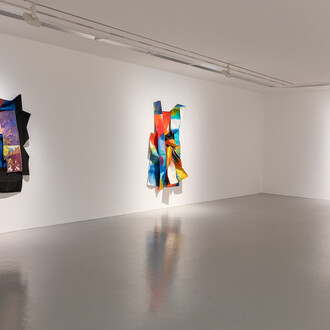This two-person exhibition is the result of Dublin City Council's Arts Plan 2009 - 2013, where Graphic Studio Dublin collaborated with Dublin City Council on an artist residency in The Red Stables. Artist Lars Wikström was selected from a large number of Swedish applicants and spent six weeks with us in July/August 2011. During this period, Wikström made a series of photopolymer etchings, called the Dublin Diary, which have since been exhibited in Sweden. Following the success of Wikström’s stay in Dublin, Graphic Studio Dublin artists were invited to spend six weeks in Sweden and Grafikverkstan Godsmagasinet (GG) in Uttersberg welcomed artist Sharon Lee during the summer of 2012.
Sharon Lee’s exhibition, ‘Primordial soup’ explores the nature of the origin of life, one of the most intriguing questions in biology. In 1953 Stanley L. Miller flipped a switch sending electric current through a chamber containing a combination of methane, ammonia, hydrogen and water. The experiment yielded organic compounds including amino acids - the building blocks of life - composing his theory of the origins of life. In this exhibition Lee reacts to Miller’s idea that the simple building blocks of unassuming detritus can evolve into organic life systems.
During the residency in Uttersberg, Sweden, Lee collected discarded books and papers from the loppis (flea markets). Recombining and collaging these found printed images with her own hand drawn stone lithographs, Lee then over-printed and created layered images and reconstituted books that resemble palimpsests. Reduced simplified forms and outlines from these books reappear in the images to create abstract forms.
Lars Wikström’s exhibition entitled ‘Aramu Muru (Woodcuts)’ features a number of large woodcuts inspired by Aramu Muru in Peru, which is an enormous stone portal located in Hayu Marca (City of the Gods) near the shores of Lake Titicaca. Giant crests of red granite rise from the dry soil of Altiplano, where erosion processes have formed bridges, grottoes and natural sculptures. Aramu Muru is cut in the side of one such granite crest. This portal is 7m high and 7m wide, with a "T" shaped alcove in the bottom middle. Local legends say that Aramu Muru is seen as a portal to a spirit world, and it continues to be an inspiration for many contemporary stories and pseudoscientific works.
Wikström uses new and old techniques in his working process, binding together today and yesterday, which emphasises the continuum of time, a strong theme throughout his work.



















